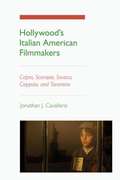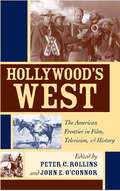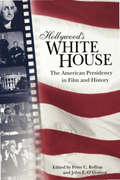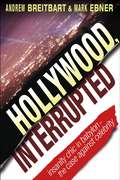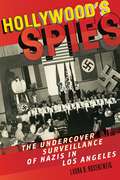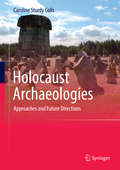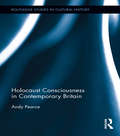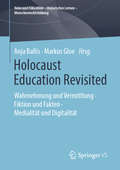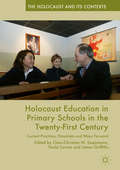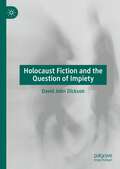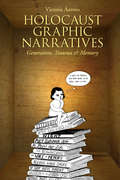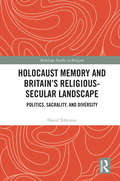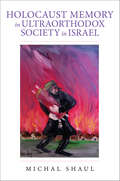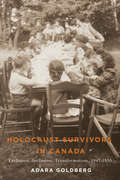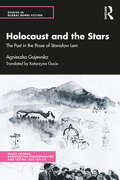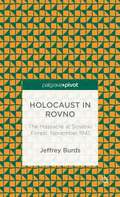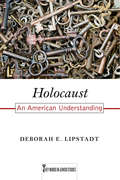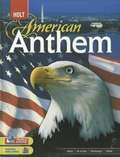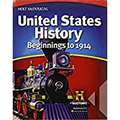- Table View
- List View
Hollywood's Italian American Filmmakers: Capra, Scorsese, Savoca, Coppola, and Tarantino
by Jonathan J. CavalleroHollywood's Italian American Filmmakers explores the different ways in which Italian American directors from the 1920s to the present have responded to their ethnicity. While some directors have used film to declare their ethnic roots and create an Italian American "imagined community," others have ignored or even denied their background. Jonathan J. Cavallero examines the films of Frank Capra, Martin Scorsese, Nancy Savoca, Francis Ford Coppola, and Quentin Tarantino with a focus on what the films reveal about each director's view on Italian American identities. Whereas Capra's films highlight similarities between immigrant characters and WASP Americans, Scorsese accepts his ethnic heritage but also sees it as confining. Similarly, many of Coppola's films provide a nostalgic treatment of Italian American identity, but with little criticism of the culture's more negative aspects. And while Savoca's movies reveal her artful ability to recognize how ethnic, gender, and class identities overlap, Tarantino's films exhibit a playfully postmodern engagement with Italian American ethnicity. Cavallero's exploration of the films of Capra, Scorsese, Savoca, Coppola, and Tarantino demonstrates how immigrant Italians fought prejudice, how later generations positioned themselves in relation to their predecessors, and how the American cinema, usually seen as a cultural institution that works to assimilate, has also served as a forum where assimilation was resisted.
Hollywood's War with Poland, 1939–1945
by M.B.B. Biskupski&“This passionate, carefully researched, richly detailed, well-written study&” reveals the political motives behind WWII Hollywood&’s portrayal of Poles (Choice). During World War II, Hollywood studios supported the war effort by making patriotic movies designed to raise the nation's morale. Often the characterizations were as black and white as the movies themselves: Americans and their allies were heroes, while everyone else was a villain. The peoples of Norway, France, Czechoslovakia, and England were all good because they had been invaded or victimized by Nazi Germany. Yet Poland—the first country to be invaded by the Third Reich—was repeatedly represented in a negative light. In this prize-winning study, Polish historian M. B. B. Biskupski explores why. Biskupski presents a close critical study of prewar and wartime films such as To Be or Not to Be, In Our Time, and None Shall Escape. Through memoirs, letters, diaries, and memoranda written by screenwriters, directors, studio heads, and actors, Biskupski examines how the political climate, and especially pro-Soviet sentiment, influenced Hollywood films of the time. Winner of the Oscar Halecki PrizeA Choice Outstanding Academic Title
Hollywood's West: The American Frontier in Film, Television, & History
by Peter C. Rollins and John E. O’Connor&“An excellent study that should interest film buffs, academics, and non-academics alike&” (Journal of the West). Hollywood&’s West examines popular perceptions of the frontier as a defining feature of American identity and history. Seventeen essays by prominent film scholars illuminate the allure of life on the edge of civilization and analyze how this region has been represented on big and small screens. Differing characterizations of the frontier in modern popular culture reveal numerous truths about American consciousness and provide insights into many classic Western films and television programs, from RKO&’s 1931 classic Cimarron to Turner Network Television&’s recent made-for-TV movies. Covering topics such as the portrayal of race, women, myth, and nostalgia, Hollywood&’s West makes a significant contribution to the understanding of how Westerns have shaped our nation&’s opinions and beliefs—often using the frontier as metaphor for contemporary issues.
Hollywood's White House: The American Presidency in Film and History
by Peter C. Rollins and John E. O’ConnorFrom action flicks to biopics to SNL skits, how presidents are portrayed on screen: &“An interesting study of the real presidency and the reel presidency.&” —USA Today Magazine Winner of the Popular Culture Association&’s Ray and Pat Browne Book Award Whether serious or satirical, biographical or fictional, the ways that US presidents are depicted in popular culture reveal much about us as a nation. The contributors to Hollywood&’s White House examine the historical accuracy of presidential depictions, illuminate their influence, and uncover how they reflect the concerns of their times and the social and political visions of the filmmakers. With reflections on portrayals of Washington, Adams, Lincoln, FDR, Nixon, and more, this volume, which includes a comprehensive filmography and a bibliography, is ideal for both historians and film enthusiasts. &“An engaging collection.&” —Robert Brent Toplin, author of Reel History: In Defense of Hollywood
Hollywood, Interrupted: Insanity Chic in Babylon -- The Case Against Celebrity
by Mark Ebner Andrew Breitbart"Reading Hollywood Interrupted is like sitting on a stakeout and having a telescopic view into the darkest reaches of the corruption and perversity of today's celebrity culture. From the very first page to the last, Breitbart and Ebner's probing reporting spells out in graphic detail how Hollywood lives by a set of norms the rest of America finds appropriately appalling--and endlessly fascinating. The authors have the unusual courage to take on Scientology. They provide revelations about Michael Jackson's sickness that go beyond even today's headlines. They rip the phony veneer off the political correctness of Rosie O'Donnell and Barbra Streisand. They give readers a behind-the-scenes understanding of how snooping private eyes and ruthless information brokers feed scoops to the tabloids. And, in one riveting chapter, they document how a young woman in the AOL backroom unmasked the bizarre fetishes of some of Tinseltown's top names. Hollywood. Interrupted no channel fluff. It's disturbing stuff. But it's all too real and it's utterly riveting."
Hollywood’s Spies: The Undercover Surveillance of Nazis in Los Angeles (Goldstein-Goren Series in American Jewish History #11)
by Laura B RosenzweigThe remarkable story of the Jewish moguls in Hollywood who established the first anti-Nazi Jewish resistance organization in the country in the 1930s.Finalist, Celebrate 350 Award in American Jewish Studies The 1939 film Confessions of a Nazi Spy may have been the first cinematic shot fired by Hollywood against Nazis in America, but it by no means marked the political awakening of the film industry&’s Jewish executives to the problem. Hollywood&’s Spies tells the remarkable story of the Jewish moguls in Hollywood who paid private investigators to infiltrate Nazi groups operating in Los Angeles, establishing the first anti-Nazi Jewish resistance organization in the country—the Los Angeles Jewish Community Committee (LAJCC). Drawing on more than 15,000 pages of archival documents, Laura B. Rosenzweig offers a compelling narrative illuminating the role that Jewish Americans played in combating insurgent Nazism in the United States in the 1930s. Forced undercover by the anti-Semitic climate of the decade, the LAJCC partnered with organizations whose Americanism was unimpeachable, such as the American Legion, to channel information regarding seditious Nazi plots to Congress, the Justice Department, the FBI and the Los Angeles Police Department.Hollywood&’s Spies corrects the decades-long belief that American Jews lacked the political organization and leadership to assert their political interests during this period in our history and reveals that the LAJCC was one of many covert &“fact finding&” operations funded by Jewish Americans designed to root out Nazism in the United States. &“A remarkable tale.&” —The Wall Street Journal &“Expose[s] a buried story about underground plots waged by Nazis against major Hollywood figures.&” —Los Angeles Review of Books
Holmes and the Ripper: Versus Narratives (Crime Files)
by Lucyna Krawczyk-ŻywkoIn versus narratives Sherlock Holmes is fighting or otherwise engaging Jack the Ripper. These texts pit the archetypal detective against the archetypal serial killer using established formulas as well as new narrative and generic features, a combination that results in their mass appeal among authors and audiences alike. The list of primary sources includes 120 titles – novels, short stories, plays, fanfiction, ‘Grand Game’ studies, movies, TV shows, video and board games – which are treated as a dialogic network of transfictional and transmedial texts. This study unpacks the versus corpus in its media dispersal by analysing Sherlock Holmes and Jack the Ripper as serial figures and culture-texts emphasising the increasing palimpsestousness of the former and the multidirectional polymorphousness of the latter, and tracing the overlapping Doylean culture-text. It also addresses the way character constellations are represented, negotiated, and fed back into the versus network, contextualising them within the coalescence of fact and fiction, Gothic and crime fiction frames, cultural memory, neo-Victorianism, and biofiction.
Holocaust Archaeologies
by Caroline Sturdy CollsHolocaust Archaeologies: Approaches and Future Directions aims to move archaeological research concerning the Holocaust forward through a discussion of the variety of the political, social, ethical and religious issues that surround investigations of this period and by considering how to address them. It considers the various reasons why archaeological investigations may take place and what issues will be brought to bear when fieldwork is suggested. It presents an interdisciplinary methodology in order to demonstrate how archaeology can (uniquely) contribute to the history of this period. Case examples are used throughout the book in order to contextualise prevalent themes and a variety of geographically and typologically diverse sites throughout Europe are discussed. This book challenges many of the widely held perceptions concerning the Holocaust, including the idea that it was solely an Eastern European phenomena centred on Auschwitz and the belief that other sites connected to it were largely destroyed or are well-known. The typologically , temporally and spatial diverse body of physical evidence pertaining to this period is presented and future possibilities for investigation of it are discussed. Finally, the volume concludes by discussing issues relating to the "re-presentation" of the Holocaust and the impact of this on commemoration, heritage management and education. This discussion is a timely one as we enter an age without survivors and questions are raised about how to educate future generations about these events in their absence.
Holocaust Consciousness in Contemporary Britain (Routledge Studies in Cultural History #27)
by Andy PearceThe Holocaust is a pervasive presence in British culture and society. Schools have been legally required to deliver Holocaust education, the government helps to fund student visits to Auschwitz, the Imperial War Museum's permanent Holocaust Exhibition has attracted millions of visitors, and Britain has an annually commemorated Holocaust Memorial Day. What has prompted this development, how has it unfolded, and why has it happened now? How does it relate to Britain's post-war history, its contemporary concerns, and the wider "globalisation" of Holocaust memory? What are the multiple shapes that British Holocaust consciousness assumes and the consequences of their rapid emergence? Why have the so-called "lessons" of the Holocaust enjoyed such popularity in Britain? Through analysis of changing engagements with the Holocaust in political, cultural and memorial landscapes over the past generation, this book addresses these questions, demonstrating the complexities of Holocaust consciousness and reflecting on the contrasting ways that history is used in Britain today.
Holocaust Education Revisited: Wahrnehmung und Vermittlung • Fiktion und Fakten • Medialität und Digitalität (Holocaust Education – Historisches Lernen – Menschenrechtsbildung)
by Markus Gloe Anja BallisDer Band wendet sich Konzepten von „Holocaust Education“ zu, die auf einer Tagung an der LMU München im Februar 2018 diskutiert worden sind: Wissenschaftlerinnen und Wissenschaftler verschiedener Disziplinen reflektierten über Zieldimensionen, mediale Repräsentationen sowie Wandel und Herausforderungen bei der Vermittlung der Themenfelder Holocaust und NS-Verbrechen. Die kritische Auseinandersetzung mit Konzepten von „Holocaust Education“ hat sich auch im 21. Jahrhundert als produktiv erwiesen: Es kann ein vielstimmiger und auf die Gegenwart bezogener Diskurs entfaltet werden, der von Fragen der Vermittlung im Klassenzimmer bis zu der Virtualisierung von Zeugenschaft in Museen und daraus resultierender didaktischer Konsequenzen reicht. Der InhaltZur Einführung • Wahrnehmung und Vermittlung • Fiktionen und Fakten • Medialität und DigitalitätDie HerausgeberDr. Anja Ballis ist Professorin am Fachbereich Didaktik der deutschen Sprache und Literatur der Ludwig-Maximilians-Universität München.Dr. Markus Gloe ist Professor am Fachbereich Politische Bildung und Didaktik der Sozialkunde an der Ludwig-Maximilians-Universität München.
Holocaust Education in Primary Schools in the Twenty-First Century: Current Practices, Potentials and Ways Forward (The Holocaust and its Contexts)
by Paula Cowan Claus-Christian W. Szejnmann James GriffithsThis collection is the first of its kind, bringing together Holocaust educational researchers as well as school and museum educators from across the globe, to discuss the potentials of Holocaust education in relation to primary school children. Its contributors are from countries that have a unique relationship with the Holocaust, such as Germany, Israel, neutral Switzerland, and Allied countries outside the UK. Their research provides new insight into the diverse ways in which primary aged students engage with Holocaust education. Chapters explore the impact of teaching the Holocaust to this age group, school and museum teaching pedagogies, and primary students’ perspectives of the Holocaust. This book will appeal to school and museum educators of primary aged students whose work requires them to teach the Holocaust, Citizenship (or Civics) or Human Rights Education. Since the turn of the twenty-first century there has been a transformation in school and museum-based Holocaust education. This book clearly demonstrates that primary education has been included in this transformation.
Holocaust Fiction and the Question of Impiety
by David John DicksonThis book discusses the issues underlying contemporary Holocaust fiction. Using Gillian Rose’s theory of Holocaust piety, it argues that, rather than enhancing our understanding of the Holocaust, contemporary fiction has instead become overly focused on gratuitous representations of bodies in pain. The book begins by discussing the locations and imagery which have come to define our understanding of the Holocaust, before then highlighting how this gradual simplification has led to an increasing sense of emotional distance from the historical past. Holocaust fiction, the book argues, attempts to close this emotional and temporal distance by creating an emotional connection to bodies in pain. Using different concepts relating to embodied experience – from Sonia Kruks’ notion of feeling-with to Alison Landsberg’s prosthetic memory – the book analyses several key examples of Holocaust literature and film to establish whether fiction still possesses the capacity to approach the Holocaust impiously.
Holocaust Graphic Narratives: Generation, Trauma, and Memory
by Victoria AaronsIn Holocaust Graphic Narratives, Victoria Aarons demonstrates the range and fluidity of this richly figured genre. Employing memory as her controlling trope, Aarons analyzes the work of the graphic novelists and illustrators, making clear how they extend the traumatic narrative of the Holocaust into the present and, in doing so, give voice to survival in the wake of unrecoverable loss. In recreating moments of traumatic rupture, dislocation, and disequilibrium, these graphic narratives contribute to the evolving field of Holocaust representation and establish a new canon of visual memory. The intergenerational dialogue established by Aarons’ reading of these narratives speaks to the on-going obligation to bear witness to the Holocaust. Examined together, these intergenerational works bridge the erosions created by time and distance. As a genre of witnessing, these graphic stories, in retracing the traumatic tracks of memory, inscribe the weight of history on generations that follow.
Holocaust Images and Picturing Catastrophe: The Cultural Politics of Seeing
by Angi BuettnerHolocaust Images and Picturing Catastrophe explores the phenomenon of Holocaust transfer, analysing the widespread practice of using the Holocaust and its imagery for the representation and recording of other historical events in various media sites. It investigates the use of Holocaust imagery in political and legal discourses, in critical thinking and philosophy, as well as in popular culture, to provide a fresh theorisation of the manner in which the Holocaust comes loose from its historical context and is applied to events and campaigns in the contemporary public sphere. Richly illustrated with concrete examples, including prominent, international animal rights activism, the Israeli-Palestinian conflict and the genocide in Rwanda, this book traces the visual rhetoric of Holocaust imagery and its application to events other than the genocide of Jewish people With its discussion of the wide range of issues arising with this form of 'Holocaust-transfer', the generalization of the Holocaust as a metaphor in representations of catastrophe, as well as in other cultural locations, Holocaust Images and Picturing Catastrophe will appeal to those working in the fields of holocaust studies, cultural and visual culture studies, sociology, and media studies.
Holocaust Memory and Britain’s Religious-Secular Landscape: Politics, Sacrality, And Diversity (Routledge Studies in Religion)
by David TollertonBritish state-supported Holocaust remembrance has dramatically grown in prominence since the 1990s. This monograph provides the first substantial discussion of the interface between public Holocaust memory in contemporary Britain and the nation’s changing religious-secular landscape. In the first half of the book attention is given to the relationships between remembrance activities and Jewish, Muslim, Christian, and post-Christian communities. Such relationships are far from monolithic, being entangled in diverse histories, identities, power-structures, and notions of ‘British values’. In the book’s second half, the focus turns to ways in which public initiatives concerned with Holocaust commemoration and education are intertwined with evocations and perceptions of the sacred. Three state-supported endeavours are addressed in detail: Holocaust Memorial Day, plans for a major new memorial site in London, and school visits to Auschwitz. Considering these phenomena through concepts of ritual, sacred space, and pilgrimage, it is proposed that response to the Holocaust has become a key feature of Britain’s 21st century religious-secular landscape. Critical consideration of these topics, it is argued, is necessary for both a better understanding of religious-secular change in modern Britain and a sustainable culture of remembrance and national self-examination. This is the first study to examine Holocaust remembrance and British religiosity/secularity in relation to one another. As such, it will be of keen interest to scholars of Religious Studies, Jewish studies and Holocaust Studies, as well as the Sociology of Religion, Material Religion and Secularism.
Holocaust Memory and National Museums in Britain (The Holocaust and its Contexts)
by Emily-Jayne StilesThis book explores the Holocaust exhibition opened within the Imperial War Museum (IWM) in 2000; setting out the long and often contentious debates surrounding the conception, design, and finally the opening of an important exhibition within a national museum in Britain. It considers a process of memory-making through an assessment of Holocaust photographs, material culture, and survivor testimonies; exploring theories of cultural memory as they apply to the national museum context. Anchored in time and place, the Holocaust exhibition within Britain’s national museum of war is influenced by, and reflects, an international rise in Holocaust consciousness in the 1990s. This book considers the construction of Holocaust memory in 1990s Britain, providing a foundation for understanding current and future national memory projects. Through all aspects of the display, the Holocaust is presented as meaningful in terms of what it says about Nazism and what this, in turn, says about Britishness. From the original debates surrounding the inclusion of a Holocaust gallery at the IWM, to the acquisition of Holocaust artefacts that could act as 'concrete evidence' of Nazi barbarity and criminality, the Holocaust reaffirms an image of Britain that avoids critical self-reflection despite raising uncomfortably close questions. The various display elements are brought together to consider multiple strands of the Holocaust story as it is told by national museums in Britain.
Holocaust Memory in Ultraorthodox Society in Israel (Perspectives on Israel Studies)
by Michal ShaulHow did the Ultraorthodox (Haredi) community chart a new path for its future after it lost the core of its future leaders, teachers, and rabbis in the Holocaust? How did the revival of this group come into being in the new Zionist state of Israel? In Holocaust Memory in Ultraorthodox Society in Israel, Michal Shaul highlights the special role that Holocaust survivors played as they rebuilt and consolidated Ultraorthodox society. Although many Haredi were initially theologically opposed to the creation of Israel, they have become a significant force in the contemporary life and politics of the country. Looking at personal and public experiences of Ultraorthodox survivors in the first years of emigration from liberated Europe and breaking down how their memories entered the public domain, Shaul documents how they were incorporated into the collective memories of the Ultraorthodox in Israel. Holocaust Memory in Ultraorthodox Society in Israel offers a rare mix of empathy and scholarly rigor to understandings of the role that the community's collective memories and survivor mentality have played in creating Israel's national identity.
Holocaust Survivors in Canada: Exclusion, Inclusion, Transformation, 1947-1955
by Adara GoldbergIn the decade after the Second World War, 35,000 Jewish survivors of Nazi persecution and their dependants arrived in Canada. This was a watershed moment in Canadian Jewish history. The unprecedented scale of the relief effort required for the survivors, compounded by their unique social, psychological, and emotional needs challenged both the established Jewish community and resettlement agents alike. Adara Goldberg’s Holocaust Survivors in Canada highlights the immigration, resettlement, and integration experience from the perspective of Holocaust survivors and those charged with helping them. The book explores the relationships between the survivors, Jewish social service organizations, and local Jewish communities; it considers how those relationships—strained by disparities in experience, language, culture, and worldview—both facilitated and impeded the ability of survivors to adapt to a new country. Researched in basement archives and as well as at Holocaust survivors’ kitchen tables, Holocaust Survivors in Canada represents the first comprehensive analysis of the resettlement, integration, and acculturation experience of survivors in early postwar Canada. Goldberg reveals the challenges in responding to, and recovering from, genocide—not through the lens of lawmakers, but from the perspective of “new Canadians” themselves.
Holocaust and the Stars: The Past in the Prose of Stanisław Lem (Studies in Global Genre Fiction)
by Agnieszka GajewskaThis book is a groundbreaking study of one of the greatest science fiction writers, the Polish master Stanisław Lem. It offers a new direction in research on his oeuvre and corrects several errors commonly appearing in his biographies. The author painstakingly recreates the context of Lem’s early life and his traumatic experiences during the Second World War due to his Jewish background, and then traces these through original and brilliant readings of his fiction and non-fiction. She considers language, worldbuilding, themes, motifs and characterization as well as many buried allusions to the Holocaust in Lem’s published and archival work, and uses these fragments to capture a different side of Lem than previously known. The book discusses various issues concerning the writer’s life, such as his upbringing in a Jewish, Zionist-minded family, the extensive relations between the Lem family and the elite of Lviv at that time, details of the Lem family killed during the German occupation and attempts to reconstruct what happened to Lem’s parents and to the writer himself after escaping the ghetto. Part of the Studies in Global Genre Fiction series, this English translation of the Polish original, which has already been considered a milestone in Lem studies, offers a fresh perspective on the writer and his work. It will be an important intervention for scholars and researchers of Jewish studies, Holocaust literature, science fiction studies, English literature, world war studies, minority studies, popular culture, history and cultural studies.
Holocaust in Rovno: The Massacre at Sosenki Forest, November 1941
by Jeffrey BurdsIn November 1941, near the city of Rovno, Ukraine, German death squads murdered over 23,000 Jews in what has been described as the second Babi Yar. This meticulous and methodologically innovative study reconstructs the events at Rovno, and in the process exemplifies efforts to form a genuinely transnational history of the Holocaust.
Holocaust: An American Understanding
by Deborah E. LipstadtImmediately after World War II, there was little discussion of the Holocaust, but today the word has grown into a potent political and moral symbol, recognized by all. In Holocaust: An American Understanding, renowned historian Deborah E. Lipstadt explores this striking evolution in Holocaust consciousness, revealing how a broad array of Americans--from students in middle schools to presidents of the United States--tried to make sense of this inexplicable disaster, and how they came to use the Holocaust as a lens to interpret their own history. Lipstadt weaves a powerful narrative that touches on events as varied as the civil rights movement, Vietnam, Stonewall, and the women's movement, as well as controversies over Bitburg, the Rwandan genocide, and the bombing of Kosovo. Drawing upon extensive research on politics, popular culture, student protests, religious debates and various strains of Zionist ideologies, Lipstadt traces how the Holocaust became integral to the fabric of American life. Even popular culture, including such films as Dr. Strangelove and such books as John Hershey's The Wall, was influenced by and in turn influenced thinking about the Holocaust. Equally important, the book shows how Americans used the Holocaust to make sense of what was happening in the United States. Many Americans saw the civil rights movement in light of Nazi oppression, for example, while others feared that American soldiers in Vietnam were destroying a people identified by the government as the enemy. Lipstadt demonstrates that the Holocaust became not just a tragedy to be understood but also a tool for interpreting America and its place in the world. Ultimately Holocaust: An American Understanding tells us as much about America in the years since the end of World War II as it does about the Holocaust itself.
Holt American Anthem
by Edward L. Ayers Robert D. Schulzinger Jesús F. de la TejaNIMAC-sourced textbook
Holt American Anthem New York
by Edward L. Ayers Robert D. Schulzinger Jesús F. de la Teja Deborah Gray WhiteHolt American Anthem New York
Holt American Anthem: Reconstruction to the Present
by Edward L. Ayers Robert D. Schulzinger Jesús F. de la Teja Deborah Gray WhiteNIMAC-sourced textbook
Holt Mcdougal United States History (United States History)
by Holt McdougalDid you ever think you would begin reading your social studies book by reading about reading? Actually, it makes better sense than you might think. You would probably make sure you learned some soccer skills and strategies before playing in a game. Similarly, you need to learn some reading skills and strategies before reading your social studies book. In other words, you need to make sure you know whatever you need to know in order to read this book successfully.
